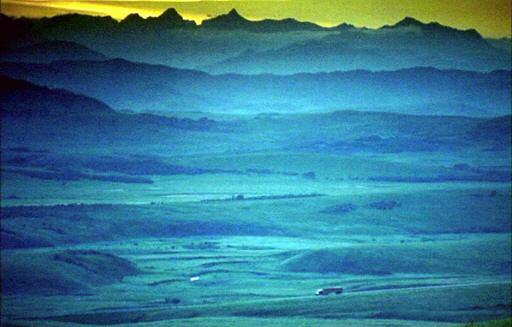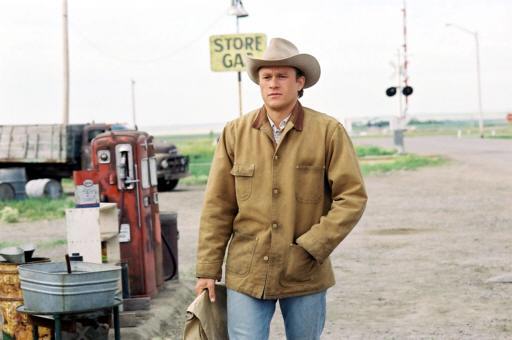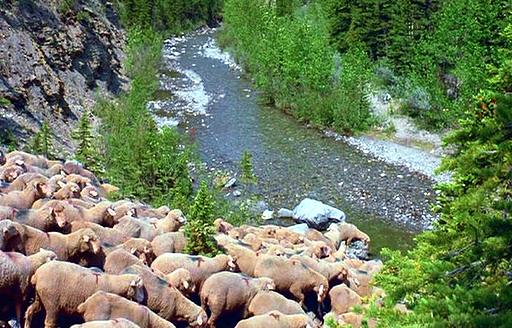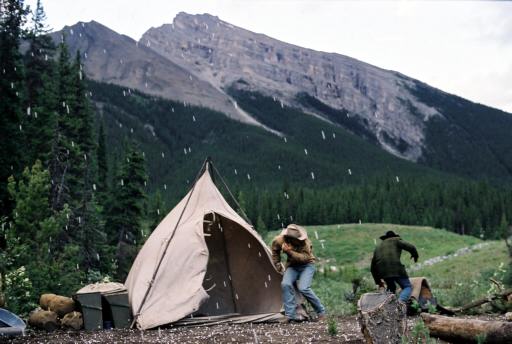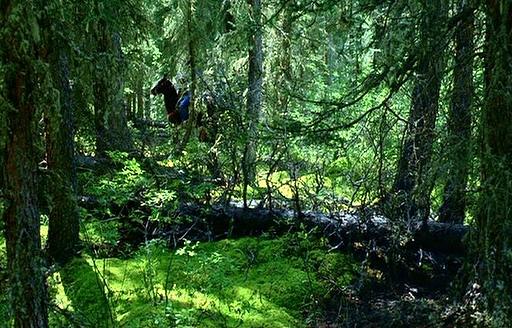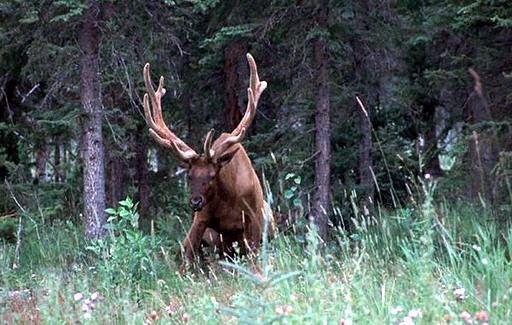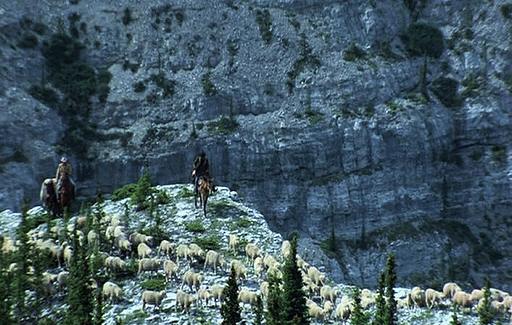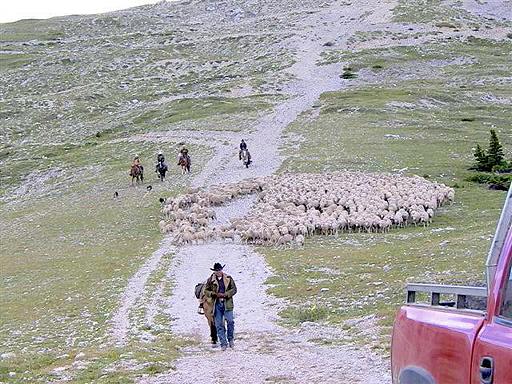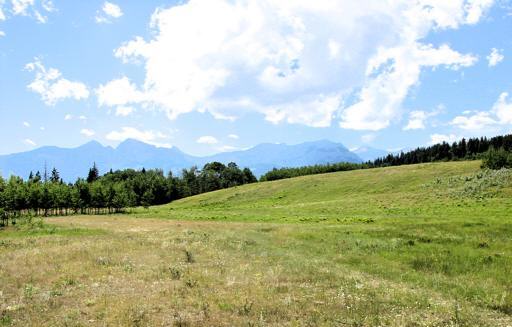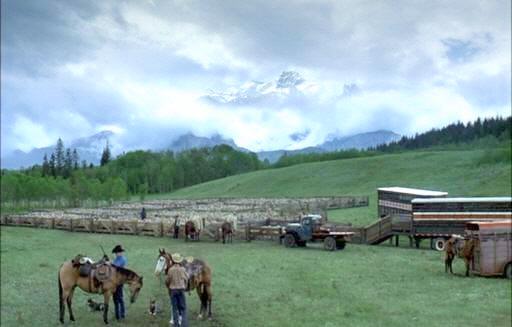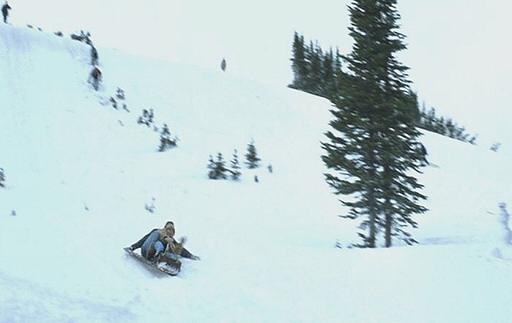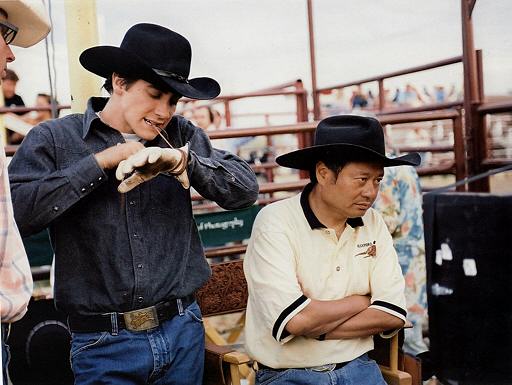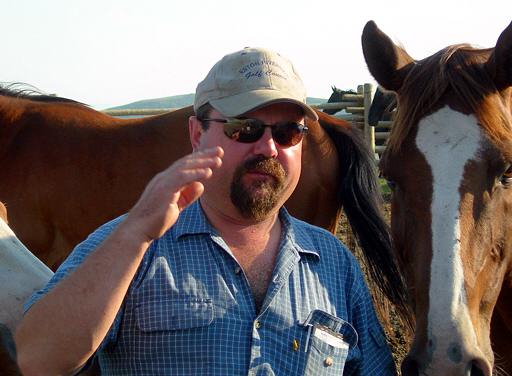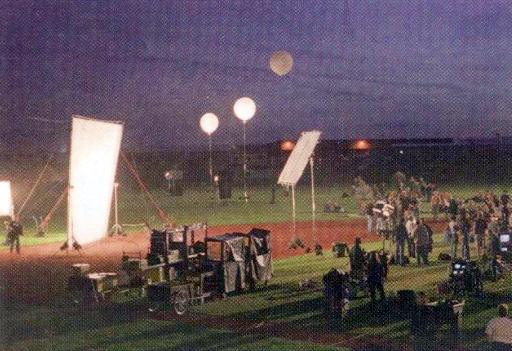The Opening Shot? We did a lot of planning for the opening shot of the cattle truck, not knowing exactly what it eventually was going to be like. As it happened, we did the opening after we were done with everything else. Just a small crew—Ang Lee, Peter Wunstorf [second unit director of photography], and myself. It was possibly my favorite day on a set, ever. [Wistfully] We struck out through the mountains, and we had doubles riding on ridges. We did the cattle truck on the highway near the end of that day.
Brokeback Mountain was the kind of film where every frame was a painting. During post-production they quite literally painted with visual elements, such as mountains and skies. We were gathering those elements on film that day. I think Peter and I got most of what [Ang Lee] needed, but there is always more. Once you get into the [post-production editing] suite you see things like, “It would be great to have a mountain in this corner.” There was one scene in particular that did not make it into the final film, although we talked about it considerably. It was shot inside the cab of the truck. We had a montage of all the pieces of the truck cab. We had the whole inside of the cab decked out, you know, with the tchotchkes and all that stuff. There was the ashtray on the dashboard, and we went to great trouble to find a bobble hula dancer from the 1960s. We had to have that made! And Peter Wunstorf and I went inside there and shot all the pieces to put this thing [the montage] together. When I saw the film I was a bit disappointed because I was looking forward to seeing what we had done, and there, in its place, was this big truck. 13 I was waiting, and waiting, and waiting, and then I realized that this was a much more organic way to get into the film, because they did not do the classic credit sequence at the beginning. You get into the story without bothering to do the big, slow introduction to the environment. Instead, Ang Lee opted for the wide vista which was, of course, a much better choice than to begin inside of a truck cab. But I was kind of disappointed not to see my hula dancer on the dashboard! Where is it? I’ll bet Michael Hausman has it! [Laughter.] The [deleted] Signal Gas Station scene? That [Carseland, AB] was a great place to shoot because it was so quiet except for the occasional train that goes by. When you go to these small conservative towns, everybody knows your business, and you are never sure how they are going to react. I was consistently surprised at how accommodating everybody was, even when they knew our story.
This is a good example of a small Alberta town letting us change their town around for our purposes. 14 Sheep Procession #1 and the Creek Crossing? Yea, that is all real. Sheep are not crazy about running water, let me tell you that. The crossing took a bit of coaxing. It was the wranglers who told us that to get them to cross the creek Jake should carry one of the sheep in his arms and the others would follow. It worked. What they say about sheep is true. Sheep are sheep; they follow other sheep.
The Mule Hill? This was shot near Goat Creek with a photo double. There was a lot of background or sky replacement in the film. Much of what I did during that time was going with Peter Wunstorf, a photo double, and the horses, and we would shoot a little part of the story in whatever area we were in. Who does the sky changes? That is done by the visual effects company. In the editing process you make what we call a “rough cut,” which is essentially everything in the film together in the sequence you want. After that, you do the effects. There are various levels of effects. There are the simple dissolves, wipes, and other transitions. Then there are the more complicated visual effects; sky replacement is one of those. 15 Once the film has been edited, the director goes through and says, “I want to change the sky in this shot and the lighting in that shot,” and the visual effects people endeavor to achieve that. Where an image, such as a sky, is required, the director goes through the library material and picks out what he wants. Hopefully, it is there. Sometimes it is not, and you have to send somebody out to get a still photo. The final production ends up looking smooth, but the process is not always smooth!
The Mosses? This is near Goat Creek also. I remember Ang saying that this was a “magical spot.” It is such a beautiful area and it did not look like a lot of the other places where we were shooting. This is actually a very sensitive area that they were good enough to let us shoot in. If you go to where the creek is, near the log bridge—is that still there? [Yes] OK, if you are standing there it is to your right, in sort of a forest that divides the road from the actual campsite. If you go into that forest, you have to go deep into it, and you find springy moss. It is like walking on sponges. You will know by the moss. It is very dense in there and there are a lot of little trails. 16
The Elk? That was tricky; we had to hit an elk and get it to fall down the right way. That is incredibly difficult, since they are wild animals. We did that several times.
We did that at the Jarrett Elk Farm, near Caroline, Alberta. This is a beautiful area. Kirk Jarrett was our stunt coordinator; the farm belongs to his parents. They are incredibly kind people. 17 Sheep Procession #2 (cliff’s edge)? Those sheep were really there. Peter Wunstorf and I stayed up on Moose after they had finished shooting that day and we shot as long as we could. We stayed until they literally kicked us off of the mountain.
Moose Mountain? Because people are impressed by the rodeo, horses, and bears, we work with animals all of the time for western shows. But the biggest thing we did with animals in Brokeback Mountain was getting those sheep up on Moose Mountain. This was the longest running logistical challenge we faced. First, we had to obtain authorization to get domestic sheep in the Rocky Mountains. That was a gigantic thing that they let us do there. Because there are only a few places in the Rocky Mountains that one, wild sheep don’t frequent, and two, have some access. You see, at first they scouted for mountain locations by helicopter and looked at places that had no roads! Eventually they found Moose Mountain. At least Moose Mountain has that goat track [crude road] that goes up there. 18
So then we had somewhere in the vicinity of 900 sheep to get up there. That was two 18-wheeler tractors full. They had to stop at the bottom of the trail and drive the sheep up in smaller trucks. No one else could do anything while they were doing all of this. Then they had to set up pens near the top of the mountain for the sheep. Moose is an environmentally sensitive area. There was concern that the sheep droppings might carry seeds of invasive plant species. Among the conditions for being able to take the sheep up there was that the sheep feed did not contain any seeds. So T.J. Bews [chief wrangler] arranged this beforehand, of course, back timing for when we were going to shoot, making certain that the sheep were getting this special kind of feed. On top of all of that, the sheep pens had to be lined with tarps which kept the droppings. Also, they had to do head counts every time they removed or returned sheep to the pens, and several other times during the day. If, at any point, there was a single missing sheep, we would be shut down until we found our “lost lamb.” Completely shut down, which fortunately never happened, thanks to T.J. Bews and the wranglers we had. They did a phenomenal job. The “dog on Moose Mountain” shot appears to be a composite. The mountains in the background are reversed. There are other composite shots in the film, as well. There are many reasons why you can’t count on those mountains being where you see them in the film. Ang is a fan of effects, effects which you do not realize are effects. Nowadays, effects are used in conspicuous ways, but Ang uses effects in such a way that you’re not even aware that they are there. He uses them to tell a story. 19 It is all part of the art of composition. The director paints a picture, in this case composing the frame spatially. So if Ang wants to put a mountain there, you can cut it out and put it there. It is all done digitally. This is simple stuff. With computers today you can do entire sequences using animation. This is the simplest kind of stuff, but it can be the most effective because it seems real. Ang had specific visual effects requirements dealing with mountains, roads, rivers, vistas—the large shots. Brokeback is not a film of moving cameras. It is a still film. Which means every frame must be perfect. Which also means that sometimes he had to “move mountains.”
Everyone got a package [listing] of the visual effects he required. One of my jobs was to split away as a second unit, with the second unit director of photography and the B camera operator. We would drive down Highway 40 and Spray Lakes Road in the Kananaskis. We had discovered those places before and Ang had said, “OK, I want that mountain in this light and that mountain in this light,” and we would go back there and note the time of day and where the light was, so he ended up with what we hoped was a library of visual effects that he could use for post-production. The Toboggan scene? That was done at the Fortress Ski Area. It is closed now; the new owner is trying to get it re-opened. It needs a lot of upgrading. But we shot many scenes at Fortress because the mountains are close and we had good access. The first thing we shot there was the tobogganing, what you call “sledding.” Actually, the tobogganing site is not far from the parking lot. It is sort of above the parking lot. You pull into the main parking lot area. You go to the farthest corner from where you walk in and you keep on walking. It should be on your left. It is pretty steep actually, but it is great for tobogganing. As you may know, we had to change the story. After Ennis and Alma get married, the script called for a little “happy times” scene of them doing “doughnuts” in the truck in the snow. But there was no snow in the towns we were going to be in. So we ran all of these tests, using all kinds of polymers, ice crystals, everything. Those poor special effects guys tried every trick they could think of to make the truck do doughnuts, and, of course, it was a period truck which made it even harder because is was so heavy. We had done a bunch of tests but nothing worked well. So we were standing around, we’d just sort of finished the last “kick at the cat” attempt at special effects, and Ang was saying, “I just need something for them to do that shows that they are happy and having fun, something a little dangerous, something showing the good times.” 20 I was a little shy, and I leaned over to Michael Hausman and said, “What about tobogganing?” and he looked back at me and I said “sledding.” Michael said, “What about sledding?” and Ang looked at him and said, “That might work.” Ang rarely answers right away; he likes to think about things. So we finished our meeting. I knew Diana liked the idea. A couple of days later, she wrote the scene. So that was my little contribution to the story there.
I’ll never forget it; it was an eventful day because we were still prepping the show. We wanted to shoot the tobogganing while we had the snow. Ang wanted them to tumble out of the sled at the end. They did. At the end, they tumble out of the sled a bit. On one of the takes, Heath, who is a big guy, landed on Michelle, who is quite small, and twisted her knee, and it hurt a lot. In fact, they had to take her to Canmore to the hospital there. Heath felt terrible about it and he insisted on going with her, so he got into the ambulance and held her hand. I think they bonded over that injury. To Michelle Williams’ great credit, she never let the fact that she was recovering from the injury and in such pain afterwards, weeks afterwards, affect her performance. We were worried about that, thinking about pushing [delaying] her scenes in the schedule; it would’ve been a huge readjustment for us. To her great credit, she said it was not necessary. For the record, I want to say that all of the cast were superb professionals. They did not receive the “star treatment” on this show. Everybody was working in conditions that were much lower than those they were accustomed to in big budget films. And yet, nobody complained. They were superlative. 21 The Rodeos? Ang wanted a real rodeo so we set up a few events. It is easy to find cowboys around here. [Laughter.] We just called ‘em in and brought in some extras. The rodeo shooting was almost a documentary kind of thing until we got to the barrel racing. There we had to do specific shots to show Lureen at various angles. And, of course, there was the bull riding. There was also quite a bit of rodeo stuff that did not make the final film. We had steer wrestling and calf roping, as well.
We had a distinct advantage because we are in Calgary and we do a lot of westerns. All I have to do is to go to T.J. Bews and Kirk [Kirk Jarrett, stunt coordinator] and have a meeting for an hour and we come up with suggestions, and we can go directly from there. Even though Ang Lee and Michael Hausman were impressed by how smoothly the rodeo scenes went, for us, this is simple stuff. You mentioned T.J. Bews. Yes. His whole family is intertwined in the history of western filmmaking in Alberta. They are really a classic family; I have worked with them all. T.J. did most of the animal work on this film, including a lot of stuff you don’t see. You know, all of those sheep on the screen do not come from one place. T.J. had to broker deals with the Hutterite farmers because they are the main suppliers of sheep in the province. He had to get them to trust him, essentially with their livelihood; there is a whole story behind that. 22
Because we do a lot of westerns, most of this stuff is pretty well established—horses, cattle, and rodeo acts. But it was no piece of cake to get 900 sheep up a mountain, and T.J. Bews deserves a lot of credit for that. The [Electra] and [Childress] rodeos were both shot in the same ring. One night and one day, of course, using different angles. You actually shot it at night? Yes. I wish they would find a way around it, but you cannot fake night! In those old spaghetti westerns where they shot “day for night,” it looks “day for night.” So it has to be the real thing. That means that during summertime in Alberta you have about seven hours of darkness to get it right. When the sun comes up over the horizon, you’re “wrapped”! So it is tricky. Whereas we have 18 hours of daylight to shoot in, and most directors love that, when we have a night scene we really hustle. This is especially true when, as we did here, there is stunt riding. Bulls don’t always go where you tell them to. They go wherever they want to! The Fireworks scene? I love this scene in the movie, but it was painful to shoot. It was pouring, pouring, and this again created a scheduling issue. We had to come back to this scene two times from the original schedule. 23 We had a fight sequence and a huge lighting setup. And then there were the fireworks! Also, it is usually very windy there. You have to be extremely careful in windy areas when you are working with fireworks. So there was a big question mark right up to the time that scene was shot as to whether it would be calm enough for us to shoot fireworks.
Well, it was not windy at all, so initially we thought we were going to be lucky, but then it started to rain. And it rained, and it was wet—so wet. The babies were crying. Poor Heath. We had twin babies, and we kept trying to switch them out, but they were not happy, they did not like the wet and the cold. And they were screaming through the whole scene. I am sure Heath is an excellent father, because any time we had kids around, Heath was great with them. He felt so bad for those babies, he just wanted for them not to have to be there. It is an intense scene. Heath’s silhouette against the exploding fireworks is most people’s favorite frame, if they had to pick a favorite frame. That took three nights. We had to move back to this location from other things we shot during the day. Because we were not scheduled to shoot this over three nights, we had to shoot what we were originally supposed to do during the day in two days over three days instead, and add to that the night shooting on this scene. We’d done the wide shot but we had to go back and do the smaller, tighter shots over the next two nights. It was complex, and it was a lot of work. 24 |
||||
